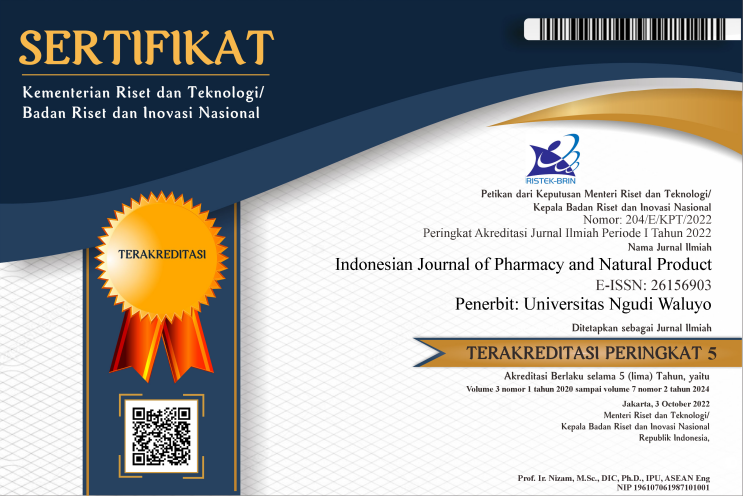Pengaruh Trietanolamin Dan Asam Stearat Terhadap Mutu Fisik Dan Stabilitas Mekanik Krim Sari Buah Tomat
DOI:
https://doi.org/10.35473/ijpnp.v4i2.1342Keywords:
Tomato, cream, triethanolamine, stearic acid, stabilityAbstract
Tomatoes contain lycopene which is an antioxidant. Antioxidant preparations can be made in the form of a cream with components of an oil phase, a water phase and an emulsifier. Emulsifiers that can be used are triethanolamine (TEA) and stearic acid. This study aims to determine the effect of triethanolamine and stearic acid as emulsifiers on the physical quality and mechanical stability of tomatoes extract cream. The use of triethanolamine and stearic acid with a ratio of 2%:5%; 3%:10%; 4%:15%. The test are the physical characteristics of tomatoes extract cream included organoleptic, homogeneity, cream type, pH, viscosity, spreadability, adhesion, protection and mechanical stability using the centrifugation method. The results of the phytochemical screening of tomatoes extract were positive for triterpenoids. The test results of the three cream formulas are odorless, semi-solid form, light orange to white color, homogeneous, cream type M/A, pH 5.25 - 6.26; viscosity 5,376 cP - 14,370 cP, spreadability 4 - 5,067 cm, adhesion 4 - 11.6 seconds, protection power 2 - 5.2 seconds. The three cream formulas did not undergo phase separation. The higher concentration of TEA and stearic acid had an effect on viscosity, pH value, adhesion, dispersibility and protection, but had no effect on organoleptic, homogeneity, cream type, and stability. tomatoes extract cream with a concentration of TEA:stearic acid 2%:5% gave the best physical quality.References
Agustina, L., Yulianti, M., Shoviantari, F., & Sabban, I. F. (2017). Formulasi dan Evaluasi Sabun Mandi Cair dengan Ekstrak Tomat (Solanum Lycopersicum L.) sebagai Antioksidan. Jurnal Wiyata Penelitian Sains Dan Kesehatan, 4(2), hal. 104-110.
Aulton, M E. (2003). Pharmaceutics The Science of Dosage Form Design, 408. ELBS Fonded by British Goverment.
Astutik, P., Yuswantina, R., Vifta, R.L. (2021). Perbandingan Aktivitas Antifungi Ekstrak Etanol 70% Dan 96% Buah Parijoto (Medinilla speciosa) Terhadap Candida albicans. Journal of Holistics and Health Science. 32-41
Azkiya, Z., Ariyani, H., dan Setia Nugraha, T. (2017). Evaluasi sifat fisik krim ekstrak jahe merah (Zingiber officinale Rosc. var. rubrum) sebagai anti nyeri. Current Pharmaccutica Sciences, 1(1), 12–18.
Departemen Kesehatan Republik Indonesia. (2014). Farmakope Indonesia Edisi V. Departemen Kesehatan Republik Indonesia, Jakarta.
Garg, A., Aggarwal, D., Garg, S., Singla A.K. (2002). Spreading of Semisolid Formulations. Pharmaceutical Technology.
Habibi, A. I., Firmansyah, R. A., & Setyawati, S. M. (2018). Skrining Fitokimia Ekstrak n-Heksan Korteks Batang Salam (Syzygium polyanthum). Indonesian Journal of Chemical Science, 7(1), 1–4.
Imam, D. (2006). Pengaruh Pemberian Jus Buah Tomat (Lycopersicum esculentum Mill) terhadap Motilitas Spermatozoa Mencit Balb/c Jantan yang Diberi Paparan Asap Rokok. Artikel Ilmiah, Fakultas Kedokteran, Universitas Diponegoro Semarang.
Kalangi, S. J. R. (2014). Histofisiologi Kulit. Jurnal Biomedik (Jbm), 5(3), 12–20. https://doi.org/10.35790/jbm.5.3.2013.4344
Lumentut, N., Edi, H. J., dan Rumondor, E. M. (2020). Formulasi dan Uji Stabilitas Fisik Sediaan Krim Ekstrak Etanol Kulit Buah Pisang Goroho (Musa acuminafe L.) Konsentrasi 12.5% Sebagai Tabir Surya. Jurnal MIPA, 9(2), 42. https://doi.org/10.35799/jmuo.9.2.2020.28248
Maulida, D., dan Zulkarnaen, N. (2010). Ekstraksi antioksidan (likopen) dari buah tomat dengan menggunakan solven campuran, n–heksana, aseton, dan etanol. Skripsi, Jurusan Teknik Kimia Fakultas Teknik Universitas Diponegoro, Semarang.
Pratasik, M. C. M., Yamlean, P. V. Y., dan Wiyono, W. I. (2019). Formulasi Dan Uji Stabilitas Fisik Sediaan Krim Ekstrak Etanol Daun Sesewanua (Clerodendron squamatum Vahl.). Pharmacon, 8(2), 261.
Pujiastuti, A., & Kristiani, M. (2019). Formulasi dan Uji Stabilitas Mekanik Hand and Body Lotion Sari Buah Tomat (Licopersicon esculentum Mill.) sebagai Antioksidan. Jurnal Farmasi Indonesia, 16(1), 42–55. https://doi.org/10.31001/jfi.v16i1.468
Ratnasari, D., dan Puspitasari, R. N. (2018). Optimasi Formula Sediaan Krim Anti-Aging Dari Ekstrak Terong Ungu (Solanum melongena L.) Dan Tomat (Solanum lycopersicum L.). Jurnal Riset Kesehatan, 7(2), 66. https://doi.org/10.31983/jrk.v7i2.3703
Rowe, R.C., Sheskey, P.J., Quinn, M.E. (2009). Handbook of Pharmaceutica Excipients (6th ed.). Pharmaceuticals Press.
Sharon, N., Anam, S., dan Yuliet. (2013). Formulasi Krim Antioksidan Ekstrak Etanol Bawang Hutan (Eleutherine palmifolia L. Merr.). Online Jurnal of Natural Science, 2(3), 111–122. http://jurnal.untad.ac.id/jurnal/index.php/ejurnalfmipa/article/view/1872
Sibuea, P. (2003). Antioksidan Senyawa Ajaib Penangkal Penuaan Dini. Sinar Harapan, Yogyakarta.
Standar Nasional Indonesia 16-4399-1996, Sediaan Tabir Surya, Badan Standarisasi Nasional, Jakarta.
Swastika A., dan Purwanto. (2013). Antiolxidant Activity Of Cream Dosage Form Of Tomato Extract (Solanum lycopersicum L.). Traditional Medicine Journal, 18(3), 132–140. https://doi.org/10.22146/tradmedj.8214
Tranggono, R. I., dan Latifah, F. (2007). Buku pegangan ilmu pengetahuan kosmetik. In Jakarta: PT. Gramedia Pustaka Utama (Vol. 3, Issue 47).
Yacobus, A. R., Lau, S. H. A., dan Syawal, H. (2019). Formulasi Dan Uji Stablitas Krim Ekstrak Methanol Daun Beluntas (Pluchea indica L.) Dari Kota Benteng Kabupaten Kepulauan Selayar Provinsi Sulawesi Selatan Jurnal Farmasi Sandi Karsa, 5(1), 19–25. https://doi.org/10.36060/jfs.v5i1.44



